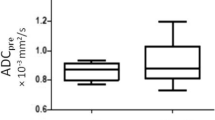Abstract
The aim of this study was to evaluate the correlation between the changes of SUVmax and of apparent diffusion coefficient (ADC) before and after neoadjuvant therapy, to enable us predict the therapy response, in patients with locally advanced rectal cancer (LARC). A total of 30 patients with LARC who underwent CRT were recruited for our study. All the patients underwent a whole body 18F-FDG-PET/CT scan and a pelvic MR examination including DW imaging for staging (PET/CT1 and RM1), and after the chemoradiation therapy (PET/CT2, and RM2). Histopathologic analysis of rectal specimen, according to tumor regression grade (Mandard’s criteria) was used as the standard reference. MR and PET-CT images were analyzed, and measurements of ADC values and SUVmax were taken. Diagnostic performance for selection of complete responders (TRG1–2) and overall diagnostic accuracy for each item were calculated. After neoadjuvant therapy, all patients were submitted to surgery. According to Mandard’s criteria, 21 tumors showed complete (TRG1) or subtotal regression (TRG2) and were classified as responders; nine tumors were classified as non responders (TRG3, 4, and 5). In all the patients, mean value of SUVmax in PET/CT1 was higher than those in PET/CT2 (P < 0.001), whereas mean ADC value was lower in RM1 than RM2 (P < 0.001), with a significant percentage decrease of values after the treatment (P < 0.005).The best predictors cut-off values for TRG response were SUVmax of 4.4 and ADC of 1.28 × 103 mm2/s with sensitivity, specificity accuracy, negative predictive value, and positive predictive values of 77.3%, 88.9%, 80.7%, 61.5%, and 94.4%, respectively. We conclude from the overall data of this study that the absolute values of SUVmax and ADC of rectal lesion after CRT were the best parameters to define the response to treatment, by differentiating fibrosis from viable tumor tissue.


Similar content being viewed by others
References
Capirci C, Rampin L, Erba PA, et al. (2007) Sequential FDG-PET/CT reliably predicts response of locally advanced rectal cancer to neo-adjuvant chemo-radiation therapy. Eur J Nucl Med Mol Imaging 34(10):1583–1593
Late effects consensus conference: RTOG/EORTC (1995) Radiother Oncol 35(1):5–7.
Capirci C, Rubello D, Chierichetti F, et al. (2004) Restaging after neoadjuvant chemoradiotherapy for rectal adenocarcinoma: role of F18-FDG PET. Biomed Pharmacother 58(8):451–457
Schelling M, Avril N, Nährig J, et al. (2000) Positron emission tomography using [(18)F]fluorodeoxyglucose for monitoring primary chemotherapy in breast cancer. J Clin Oncol 18(8):1689–1695
Swisher SG, Erasmus J, Maish M, et al. (2004) 2-Fluoro-2-deoxy-d-glucose positron emission tomography imaging is predictive of pathologic response and survival after preoperative chemoradiation in patients with esophageal carcinoma. Cancer 101(8):1776–1785
Cascini GL, Avallone A, Delrio P, et al. (2006) 18F-FDG PET is an early predictor of pathologic tumor response to preoperative radiochemotherapy in locally advanced rectal cancer. J Nucl Med 47(8):1241–1248
Hein PA, Kremser C, Judmaier W, et al. (2003) Diffusion-weighted magnetic resonance imaging for monitoring diffusion changes in rectal carcinoma during combined, preoperative chemoradiation: preliminary results of a prospective study. Eur J Radiol 45(3):214–222
Le Bihan D (1995) Molecular diffusion, tissue microdynamics and microstructure. NMR Biomed 8(7–8):375–386
Kremser C, Judmaier W, Hein P, et al. (2003) Preliminary results on the influence of chemoradiation on apparent diffusion coefficients of primary rectal carcinoma measured by magnetic resonance imaging. Strahlenther Onkol 179(9):641–649
Mandard AM, Dalibard F, Mandard JC, Marnay J, Henry-Amar M, Petiot JF, et al. (1994) Pathologic assessment of tumor regression after preoperative chemoradiotherapy of esophageal carcinoma. Clinicopathologic correlation. Cancer 73(11):2680–2686
Theodoropoulos G, Wise WE, Padmanabhan A, et al. (2002) T-level downstaging and complete pathologic response after preoperative chemoradiation for advanced rectal cancer result in decreased recurrence and improved disease-free survival. Dis Colon Rectum 45(7):895–903
Valentini V, Coco C, Picciocchi A, et al. (2002) Does downstaging predict improved outcome after preoperative chemoradiation for extraperitoneal locally advanced rectal cancer? A long-term analysis of 165 patients. Int J Radiat Oncol Biol Phys 53(3):664–674
Onaitis MW, Noone RB, Hartwig M, et al. (2001) Neoadjuvant chemoradiation for rectal cancer: analysis of clinical outcomes from a 13-year institutional experience. Ann Surg 233(6):778–785
Cho YB, Chun HK, Kim MJ, et al. (2009) Accuracy of MRI and 18F-FDG PET/CT for restaging after preoperative concurrent chemoradiotherapy for rectal cancer. World J Surg 33(12):2688–2694
Guerra L, Niespolo R, Di Pisa G, et al. (2011) Change in glucose metabolism measured by 18F-FDG PET/CT as a predictor of histopathologic response to neoadjuvant treatment in rectal cancer. Abdom Imaging 36(1):38–45
Sun YS, Zhang XP, Tang L, et al. (2010) Locally advanced rectal carcinoma treated with preoperative chemotherapy and radiation therapy: preliminary analysis of diffusion-weighted MR imaging for early detection of tumor histopathologic downstaging. Radiology 254(1):170–178
Kim SH, Lee JY, Lee JM, Han JK, Choi BI (2011) Apparent diffusion coefficient for evaluating tumor response to neoadjuvant chemoradiation therapy for locally advanced rectal cancer. Eur Radiol 21(5):987–995
Kim SH, Lee JM, Hong SH, et al. (2009) Locally advanced rectal cancer: added value of diffusion-weighted MR imaging in the evaluation of tumor response to neoadjuvant chemo- and radiation therapy. Radiology 253(1):116–125
Author information
Authors and Affiliations
Corresponding author
Rights and permissions
About this article
Cite this article
Ippolito, D., Monguzzi, L., Guerra, L. et al. Response to neoadjuvant therapy in locally advanced rectal cancer: assessment with diffusion-weighted MR imaging and 18FDG PET/CT. Abdom Imaging 37, 1032–1040 (2012). https://doi.org/10.1007/s00261-011-9839-1
Published:
Issue Date:
DOI: https://doi.org/10.1007/s00261-011-9839-1




